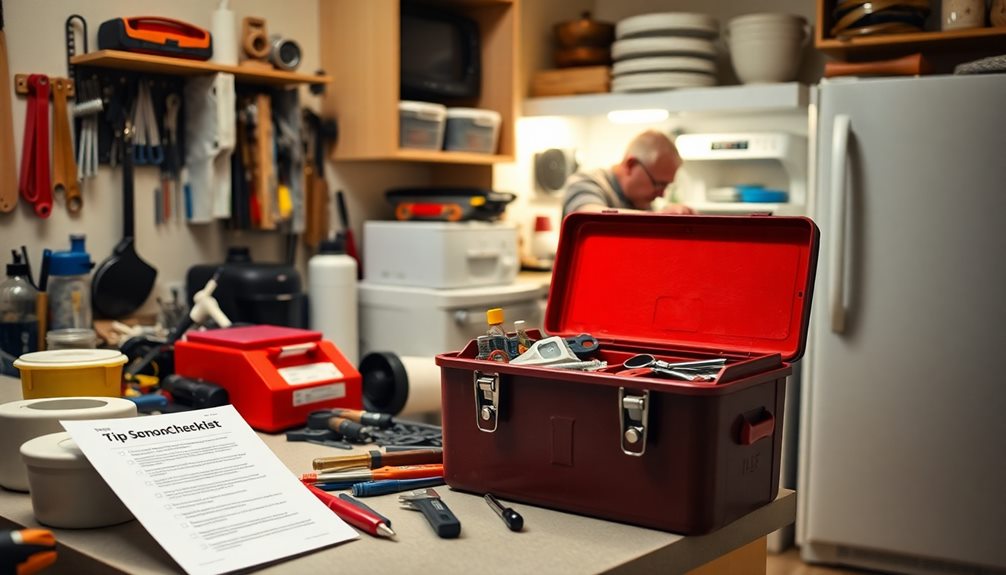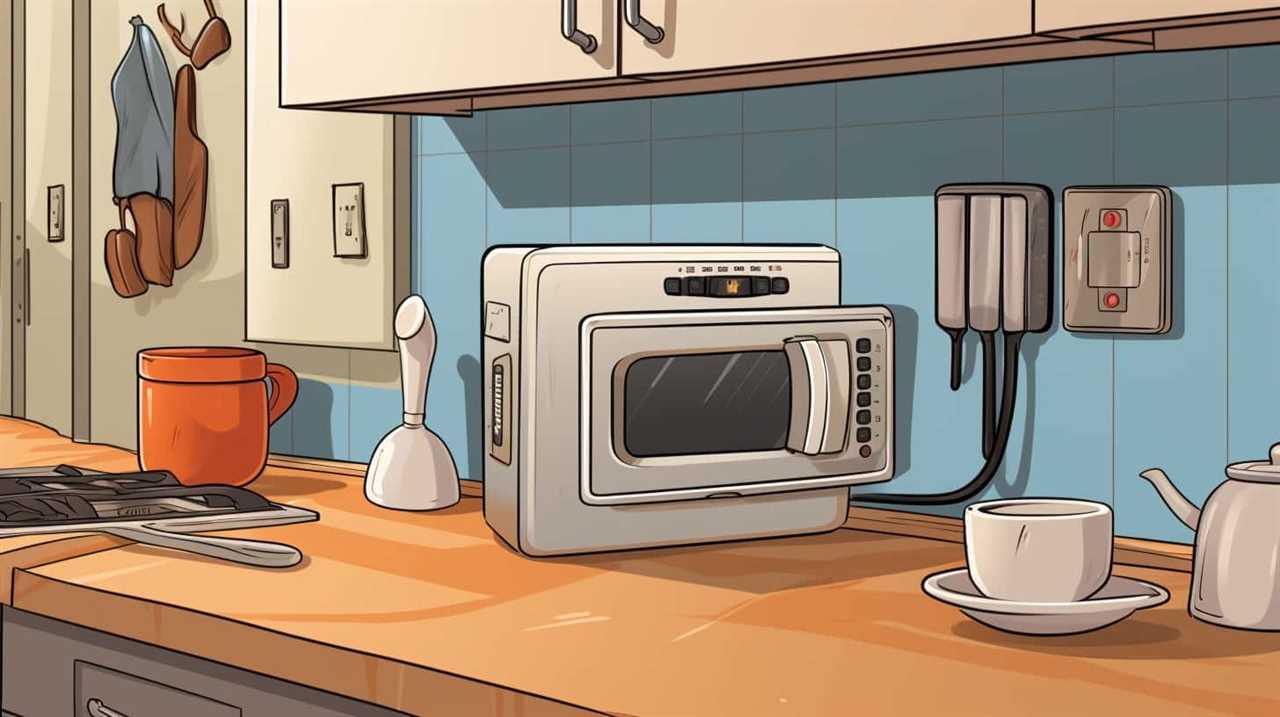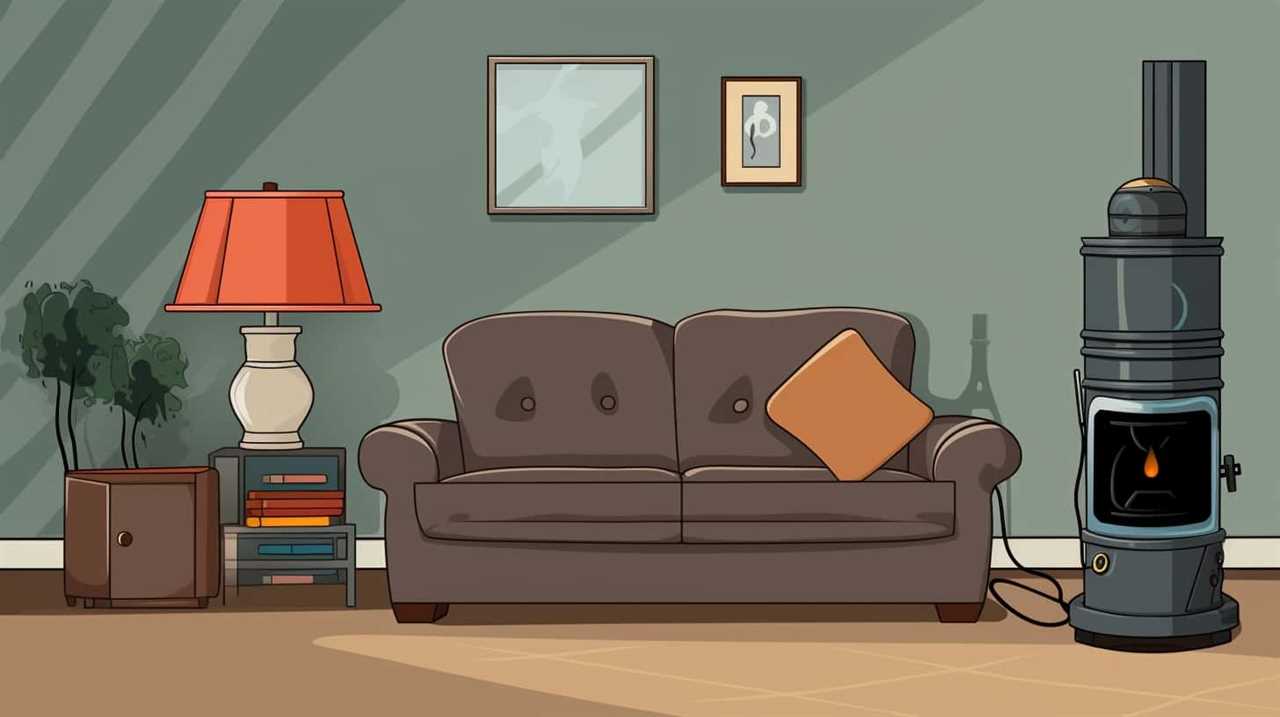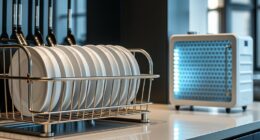Your ice maker connects securely to your water line, filtering and maintaining proper pressure for ideal ice formation. Cold water flows into a chilled mold, where a refrigeration system freezes it into cubes. Sensors monitor temperature and water levels to guarantee smooth operation, while mechanical parts loosen and eject the ice into the bin. With regular maintenance and knowing how each part works, you can keep your ice maker running efficiently—learn more about the process below.
Key Takeaways
- Water flows from the supply line into the ice maker’s reservoir and mold via a controlled inlet valve.
- The refrigeration system cools the mold, freezing water into ice cubes through temperature regulation.
- Sensors monitor temperature and water levels, signaling the system to start or stop freezing and water refilling cycles.
- Ice cubes are released from the mold by heating elements or mechanical mechanisms and fall into the storage bin.
- Regular maintenance ensures proper water flow, prevents buildup, and maintains ice quality from the water line to the finished cube.
Connecting to the Water Supply
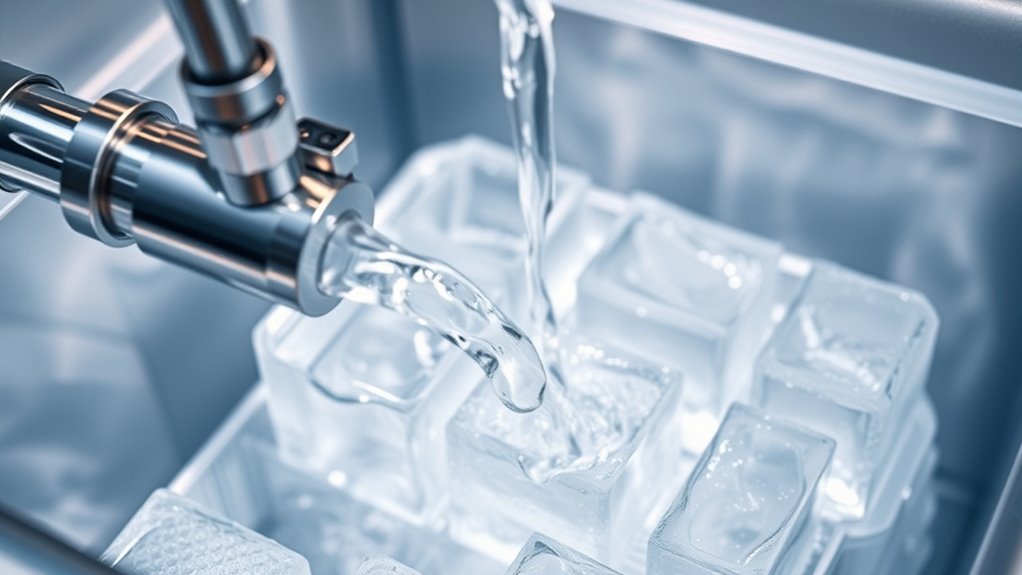
To guarantee your ice maker functions properly, it must be connected to a reliable water supply. You’ll start by attaching the water inlet hose to your home’s water line, ensuring a secure fit to prevent leaks. Most ice makers come with a valve that controls water flow, so double-check that it’s fully open. If your unit has a filter, install it correctly to keep impurities out of the water. Make sure the water pressure is adequate—too low, and the ice production slows down; too high, and it could damage the system. Regularly inspect the connections for leaks or blockages. Proper installation of the water supply is essential for consistent ice production and maintaining the longevity of your ice maker. Additionally, understanding water pressure requirements can help optimize the efficiency of your ice-making process. Maintaining connectivity of your water line also plays a crucial role in preventing potential malfunctions and ensuring steady ice production. Ensuring the proper water flow is vital for efficient operation and avoiding system damage. Being aware of water quality standards can further improve ice clarity and taste, preventing mineral build-up inside the machine.
The Freezing Process Inside the Ice Maker
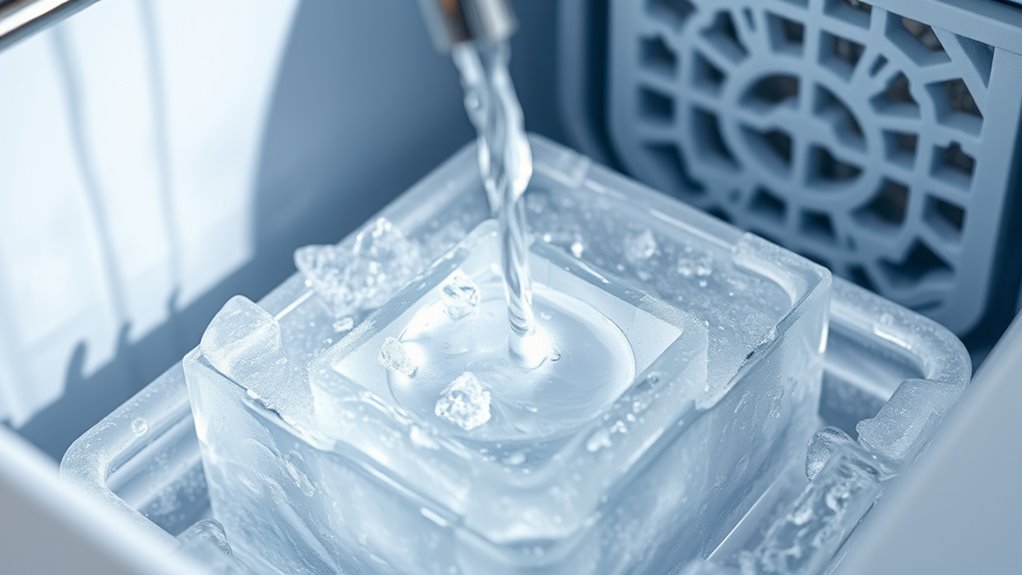
Once your ice maker is connected to a steady water supply, it begins the freezing process. Water flows into the cold mold or ice tray, which is cooled by a refrigeration system. The freezer’s evaporator coil drops the temperature below freezing, causing the water to solidify into ice. As the water contacts the cold surfaces, it freezes into individual cubes or slabs, depending on the design. During this process, a thermostat monitors the temperature, ensuring it stays low enough for proper freezing. The water gradually turns into solid ice, filling the mold completely. Ongoing monitoring of the freezing cycle helps optimize ice quality and production efficiency. Proper temperature control is essential for preventing ice from sticking together or developing cracks. Once the cubes reach the desired size, the machine prepares for the next step—harvesting and ejecting the ice—without your intervention. Incorporating proper lifestyle practices can enhance the efficiency and lifespan of your ice maker. Additionally, advancements in automation technology are making ice makers more efficient and easier to operate. Proper maintenance also plays a vital role in preventing common issues like mineral buildup and mechanical failures, ensuring consistent ice production.
Harvesting and Ejecting the Ice Cubes
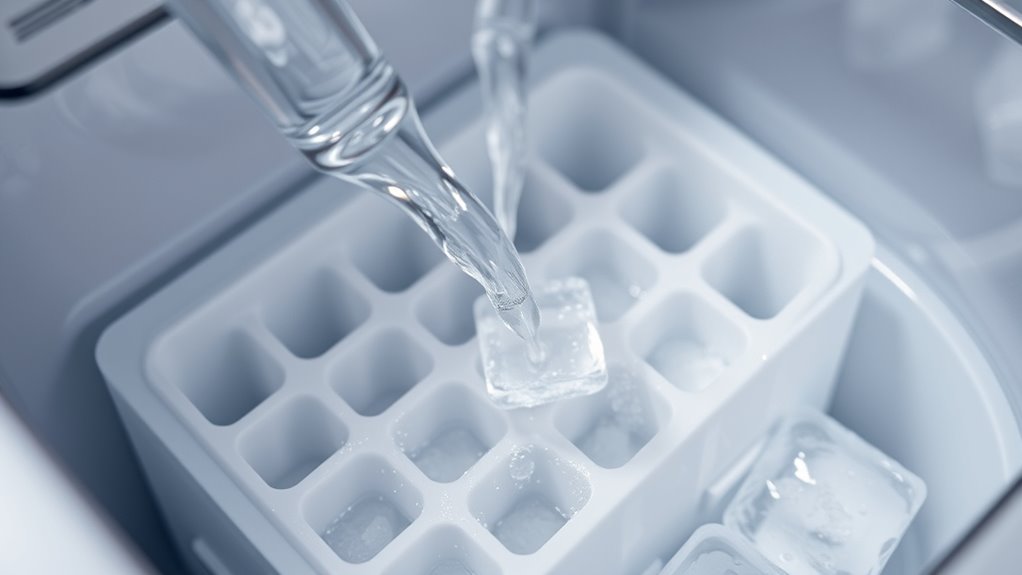
After the ice cubes have fully formed, the ice maker initiates the harvesting process by activating a mechanism that loosens them from the mold. Typically, this involves a heating element or a small electrical current that briefly warms the mold, causing the cubes to detach easily. Once loosened, a mechanical arm or a gravity-based push system gently lifts or slides the cubes out of the mold. This process happens quickly to prevent melting and ensure fresh ice for your usage. As the cubes are ejected, they fall into an ice bin or storage area. The entire cycle is automated, allowing the ice maker to efficiently repeat the process without your intervention, ensuring a steady supply of clean, ready-to-use ice. Additionally, automated cycles help maintain consistent ice production and reduce manual handling, while temperature controls ensure the ice remains frozen until needed. Proper water filtration can also improve ice clarity and hygiene, contributing to better quality ice. Modern ice makers may also incorporate sensor technology to monitor ice levels and optimize cycle timing for efficiency, which is essential for maintaining optimal ice quality.
The Role of the Temperature and Water Level Sensors

Temperature and water level sensors play a crucial role in ensuring your ice maker operates efficiently and safely. The temperature sensor monitors the ice mold’s coldness, signaling when to start or stop freezing. Meanwhile, the water level sensor checks if the water reservoir has enough water to produce ice. If the water level drops too low, it prevents the compressor from running, avoiding damage. Conversely, if the water level is too high, it signals the system to stop filling. These sensors work together to maintain ideal conditions, ensuring consistent ice production and preventing overflow or insufficient freezing. Additionally, Real Couples relationships often involve understanding and communication, which can be compared to how sensors work together to keep the system balanced. Proper calibration of these sensors is essential for optimal performance, similar to how exfoliation enhances skin clarity by promoting cell turnover. Incorporating automation technologies in the design of sensors can further improve the efficiency and reliability of the system. 1. The temperature sensor triggers the freezing cycle based on mold temperature. 2. The water level sensor detects water shortages to prevent dry freezing or overflow. 3. Both sensors send signals to control the compressor and water inlet valve, coordinating operation efficiently.
Maintenance and Troubleshooting Common Issues
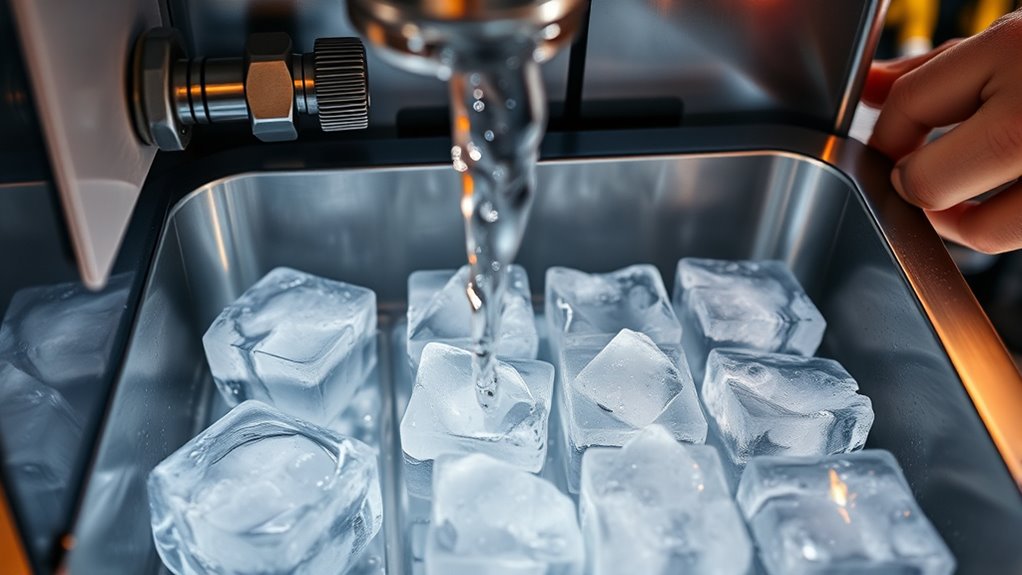
Regular maintenance is essential to keep your ice maker running smoothly and to prevent common issues from disrupting ice production. Start by cleaning the ice bin and water reservoir regularly to prevent mold and mineral buildup. Check the water supply line for leaks or blockages, and verify the water filter is replaced as recommended. If your ice maker isn’t producing enough ice, confirm that the water inlet valve is functioning correctly and that the temperature settings are appropriate. For strange noises or inconsistent ice production, inspect the fan and motor for debris or damage. If the ice cubes are clumped or cloudy, it might be time to descale the unit or replace the water filter. Addressing these issues promptly keeps your ice maker efficient and reliable.
Frequently Asked Questions
How Long Does It Typically Take for an Ice Maker to Produce a Full Batch?
You’re wondering how long it takes for an ice maker to produce a full batch. Usually, it takes about 90 minutes to 3 hours, depending on the model and conditions. Factors like ambient temperature, water temperature, and the size of the ice cubes can influence the time. So, if you start a new cycle, expect to wait roughly this amount before your ice bin is full and ready to use.
Can Ice Makers Operate Without a Dedicated Water Line?
Your question is a real game-changer—can ice makers work without a dedicated water line? Yes, you can! Portable ice makers, for example, don’t need a water hookup; they just fill the reservoir manually. It’s like having a mini ice factory on your countertop. So, if you don’t have a water line, don’t worry—you can still enjoy fresh, cold ice anytime without needing a permanent setup.
What Materials Are Used in the Construction of Ice Molds?
Ice molds are typically made from food-grade silicone, plastic, or metal. Silicone molds are flexible, making it easy to remove the ice cubes without cracking. Plastic molds are durable and lightweight, often with a non-stick surface. Metal molds, like aluminum or stainless steel, conduct cold quickly and are sturdy but less flexible. You choose based on ease of use, durability, and how quickly you want the ice to freeze.
How Energy-Efficient Are Modern Ice Makers Compared to Older Models?
Modern ice makers are more energy-efficient than older models because they use advanced compressor technology and better insulation. You’ll notice they consume less power while producing ice quickly and in larger quantities. These improvements mean you save money on electricity and reduce environmental impact. So, if you upgrade, you’ll enjoy efficient ice production without the high energy costs, making your appliance more eco-friendly and cost-effective over time.
Are There Safety Concerns Related to Mineral Deposits in the Ice?
Did you know that mineral deposits can make up to 15% of an ice cube’s weight? You should be aware that mineral buildup from your water supply can cause safety concerns, like affecting taste and potentially harboring bacteria. To keep your ice safe, regularly clean your machine, use filtered water, and check for mineral buildup. Proper maintenance helps guarantee your ice remains clean and safe to consume.
Conclusion
Now that you understand how your ice maker transforms water into glistening cubes, you can picture the process as a mini winter wonderland inside. Water flows in, freezes, then gracefully slides out as perfect cubes, ready to chill your drinks. With a little care and attention to sensors, you keep this icy symphony running smoothly. So, next time you grab a cold drink, remember the tiny miracle happening behind the scenes, turning water into invigorating ice.



